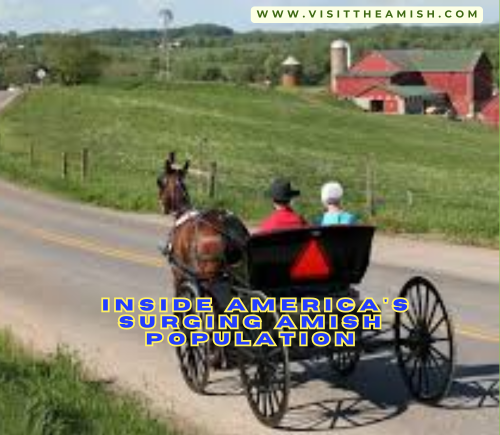The Amish Boom: How America’s Horse-and-Buggy Community is Thriving in the 21st Century
In the rolling hills of Ethridge, Tennessee, about 75 miles southwest of Nashville, a unique community is experiencing unprecedented growth. The Swartzentruber Amish, known for their strict adherence to traditional ways, have become the largest Amish settlement in the South and one of the top 20 in the nation[1][2].
This growth in Ethridge is not an isolated phenomenon. Across the United States, the Amish population is expanding at a remarkable rate, doubling approximately every 20 years[1]. In 1989, there were about 100,000 Amish living in 179 settlements in the United States and Canada. By 2010, that number had climbed to about 251,000 in 456 settlements. Fast forward to 2024, and the Amish population in North America has reached an estimated 400,910[1].
The Driving Forces Behind Amish Population Growth
The rapid expansion of the Amish community can be attributed to two primary factors:
- High Birth Rates: Amish families typically have between six and seven children on average, significantly higher than the general U.S. population[2].
- High Retention Rates: Approximately 85% or more of Amish children join the church as young adults, maintaining the community’s traditions and values[1].
Professor Joe Donnermeyer, director of the Amish census at Ohio State University, explains, “If current trends continue, the Amish population could reach a million by 2050.”
The Ethridge Experience: A Microcosm of Amish Growth
The Amish community in Ethridge, established in the mid-1940s, has grown to about 15,000 members. This growth has led to some unique challenges:
Land Scarcity: Available farmland in Ethridge has become increasingly scarce as Amish families have bought up most of the farms.
Market Saturation: The tourist market is flooded with Amish-made products like baskets, food, and furniture.
A local Amish leader, who preferred to remain anonymous due to religious reasons, stated, “It’s getting harder and harder to find land and get a good start.”
Expanding Horizons: New Settlements
As a result of this growth, the Amish are expanding to new areas. Three years ago, 100 members from Ethridge established a new settlement in Stantonville, about 75 miles away. This is one of three new settlements founded in the last 12 years.
Stantonville Mayor David Leckner welcomed the new Amish neighbors, saying, “It really is one of those ‘You’ve got to see this’ moments.” The only issue that arose was managing horse-and-buggy traffic, which was resolved through cooperation between the town and Amish officials.
Preserving Tradition in a Changing World
The Swartzentruber Amish of Ethridge are known for their particularly conservative lifestyle:
- They don’t use electricity, indoor plumbing, or telephones.
- Their buggies are all black and don’t have windshields or reflective orange triangles.
This adherence to tradition has sometimes led to conflicts with modern regulations. In Kentucky, for example, Swartzentruber men were arrested for not having state-required orange triangles on their buggies, leading to legal challenges and eventual legislative accommodation.
Economic Adaptation and Cooperation
Despite their traditional lifestyle, the Amish in Ethridge have found ways to thrive economically while working closely with their non-Amish neighbors:
Ploughboy Produce Auction: A group of Amish farmers helped fund this Amish-friendly open-air auction barn. Lynn Ward, the auction house manager, works closely with a board of five Amish farmers to run the facility.
Diverse Agricultural Production: Local Amish farmers grow a variety of crops, including tobacco and sugar cane for molasses.
Home-Based Businesses: Many Amish households sell goods directly from their homes, offering everything from homemade food products to handcrafted furniture.
Challenges and Considerations for the Future
As the Amish population continues to grow, several challenges and considerations emerge:
- Land Availability: Finding affordable farmland for new families and settlements is becoming increasingly difficult.
- Economic Diversification: Many Amish are turning to non-agricultural businesses to support their families.
- Interaction with Modern Society: Balancing traditional values with the need to interact with the outside world presents ongoing challenges.
- Environmental Impact: The expansion of Amish communities may have implications for land use and conservation efforts.
- Cultural Preservation: Maintaining Amish traditions and values in the face of rapid growth and changing surroundings remains a priority.
The Road Ahead
As the Amish population in North America approaches half a million, the community faces both opportunities and challenges. Their ability to adapt while maintaining their core values will be crucial in the coming decades.
Danny, an older Amish resident of Ethridge, summed up the community’s outlook: “We can’t know the future, but we hope most of our grandchildren will keep the faith and remain Amish.”
As America becomes increasingly urbanized and technologically dependent, the growing Amish population serves as a reminder of alternative ways of life. Their success in maintaining their traditions while adapting to economic realities offers valuable insights into community resilience and cultural preservation in the 21st century.
Citations:
[1] https://groups.etown.edu/amishstudies/amish-population-profile-2024/
[2] https://www.statenews.org/section/the-ohio-newsroom/2024-05-28/your-new-neighbors-may-drive-a-buggy-ohios-amish-population-is-growing
[3] https://groups.etown.edu/amishstudies/population-2024/
[4] https://x.com/DemographicR/status/1824584987850707025?lang=en

